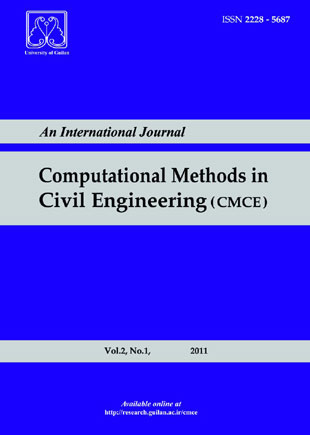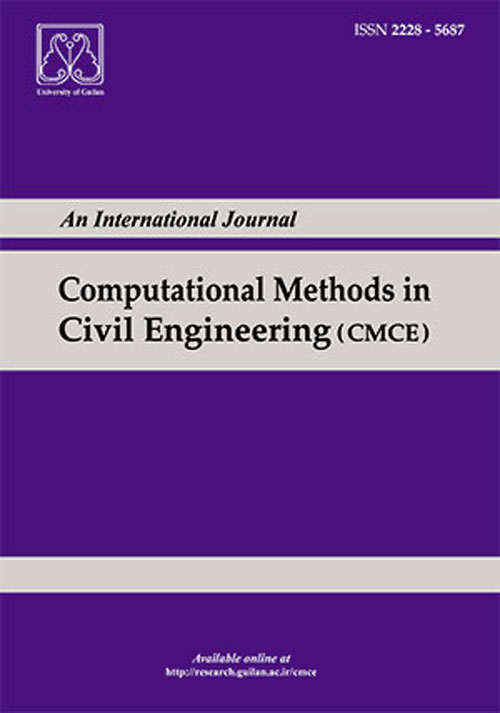فهرست مطالب

Computational Methods in Civil Engineering
Volume:2 Issue: 1, 2011
- تاریخ انتشار: 1391/03/01
- تعداد عناوین: 7
-
Page 1In this paper, the mechanical behavior of three-phase inhomogeneous materials is modeled using the meso-scale model with lattice beams for static and dynamic analyses. The Timoshenko beam theory is applied instead of the classical Euler-Bernoulli beam theory and the mechanical propertiesof lattice beam connection are derived based on the continuum medium using the non-local continuum theory. The average acceleration method is applied for dynamic modeling of crack propagation in concrete. Finally, two experimental tests, including the simple tension experiment and the Nooru-Mohamed test, are simulated using the proposed model in order to investigate the effects of dynamic crack propagation, and the results are compared with those of static analysis.
-
Page 21Micropolar plasticity provides the capability to carry out post-failure simulations of geo-structures due to microstructural considerations and embedded length scale in its formulation. An essential part of the numerical implementation of a micropolar plasticity model is the integration of the rate constitutive equations. Efficiency and robustness of the implementation hinge on the type of integration scheme employed. In this paper, two types of algorithms are developed for a critical-state micropolar plasticity model based on cutting plane and substepping integrations procedures. Performance of the two integration algorithms is first assessed in triaxial and biaxial compression tests at an element level. To evaluate the two integration schemes in a strain localization problem, biaxial compression simulations on a slightly heterogeneous specimen of sand are conducted. In all cases the substepping method performs better than the cutting plane method.
-
Page 43This study focuses on the optimization of the plane structure. Sequential quadratic programming (SQP) will be utilized, which is one of the most efficient methods for solving nonlinearly constrained optimization problems. A new formulation for the second order sensitivity analysis of the twodimensional finite element will be developed. All the second order required derivatives will be calculated. These values will be used in SQP scheme for structural optimization. Both plane stress and plane strain problems are analyzed. Numerical examples show the success and effectiveness of the suggested formulation.
-
Page 65In this paper, three dimensional (3D) static and dynamic analysis of thick plates based on the Meshless Local Petrov-Galerkin (MLPG) is presented. Using the kinematics of a three-dimensional continuum, the local weak form of the equilibrium equations is derived. A weak formulation for the set of governing equations is transformed into local integral equations on local sub-domains by using a unit test function. Nodal points are distributed in the 3D analysis domain and each node is surrounded by a cubic sub-domain to which a local integral equation is applied. The meshless approximation based on the three dimensional Moving Least-Square (MLS) is employed as the shape function to approximate the field variable of scattered nodes in the problem domain. The Newmark time integration method is used to solve the system of coupled second order ODEs. The essential boundary conditions are enforced by the direct interpolation method. Numerical examples for solving the static and transient response of elastic thick plates are demonstrated. The numerical efficiency of the proposed meshless method is demonstrated by comparing the results obtained with the available analytical and/or numerical solutions in the literature.
-
Page 83Existence of heavy minerals in water in some regions causes serious environmental pollution and affects the soil and water resources quality. Soil and water sensitive to pollutants were investigated in this research, based on the degree of sensitivity of their parameters. The samples obtained from industrial and agricultural areas for identifying water tables at higher risk and display regions that are most sensitive to pollutants. The vulnerability to pollution was investigated on the basis of environmental contaminants, hazards and hydro-geologic parameters. A sensitive DRASTIC software based model constructed with seven most sensitive parameters: depth of water (D); recharging water table (R); aquifer media (A); environment topography (T); impact of zone (I); and conductivity (C); accompanied by Arc-View software was employed. Weighting factors, stacking the parameters and sensitivity index for selected regions were analyzed based on higher risk vulnerable water. Investigation made based on index numbers for; no risk, low to medium and higher sensitive locations. The reliability of aquifer was tested against potential risk of contamination and nitrate ions which has been used to calibrate the model. Higher nitrate concentrations falling on susceptible areas were highlighted. Result of this study may provide environmental protection measures considered for similar regions to prevent groundwater from potential risk of pollution.
-
Page 95The strength of concrete is a function of the proportions of the constituent materials, namely, cement, water, fine and coarse aggregates. The conventional methods used to determine the mix proportions that will yield the desired strength, are laborious, time consuming and expensive. In this paper, a mathematical method based on modified regression theory is formulated for the prediction of concrete strength. The model can prescribe all the mixes that will produce a desired strength of concrete. It can also predict the strength of concrete if the mix proportions are specified. The adequacy of the mathematical model is tested using statistical tools.
-
Page 109The aim of this paper is to study the popular models used for the simulation of major elements of a water quality system. The present study compares results of the CE-QUAL-W2 model with the WASP5 and MIKE11 models to assess the water quality of Pasikhan River. The contaminant loadings of Nitrate and Phosphate are utilized in the CE-QUAL-W2, WASP5 and MIKE11 simulations. This study is the first report of the innovative use of three commonly used numerical models for selecting a suitable tool to simulate the rivers water quality. All three models simulated measured data reasonably well. The sensitivity analysis for CE-QUAL-W2 model shows that the model is highly sensitive to the Manning coefficient and point source flow rate. The calibrated model responses are in good agreement with the field data and can be used as scenario generators in a general strategy to conserve or improve the water quality. During the period of intense stratification, predictions from CE-QUALW2 are inconsistent better to the measured data than those from Mike11 and WASP5 due to the improved transport scheme used in CE-QUAL-W2. In general, CE-QUAL-W2 offers significant advantages over Mike11 and WASP5 in simulations of water quality in the Pasikhan River.


